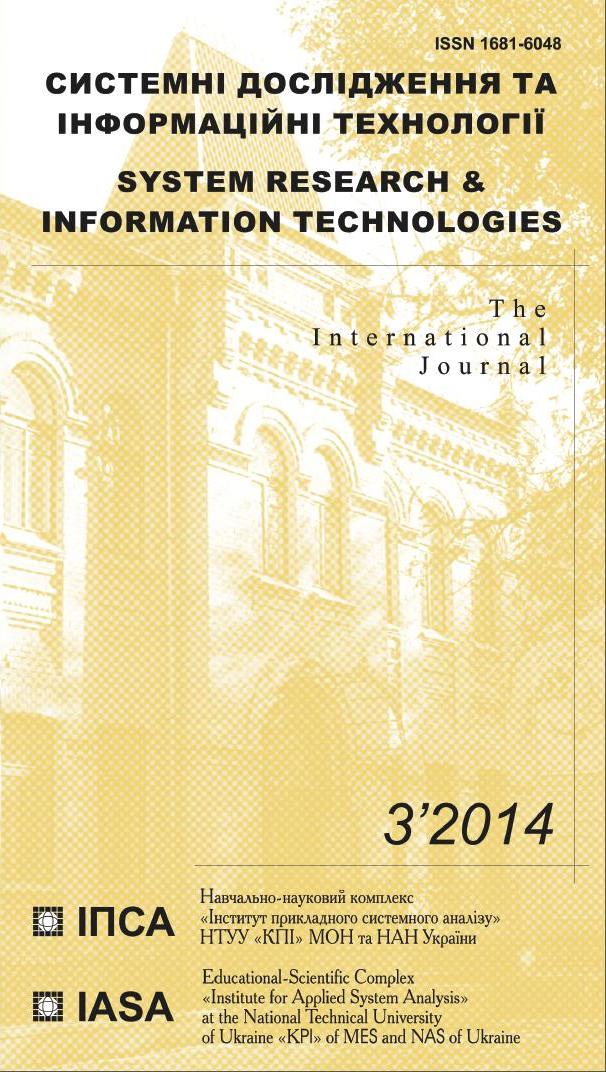Fuzzy modeling in the problem of evaluating the laser spot image quality
Abstract
Laser beam spot images have been analyzed according to a number of features which were specific to graphical objects of this kind. Statistical and geometrical informa-tional features of laser spot images were extracted; in particular, the Hemming distance between fuzzy hash function values for the analyzed and the template images is proposed as one of the features. Fuzzy hash functions allow identifying an image even in a case of small modifications. A slight change in an argument of such a function does not result in the change of its value. A fuzzy classifier model has been developed, which assigns input images to classes according to the quality of the laser spot image in them. Classification results may be interpreted as a laser beam quality indication; a measure of how well the laser beam can be focused. The system does not only identify the object on an image, a laser spot in the current context, but also provides a qualitative estimation of its correspondence to the template image.
References
Zaychenko YU.P., Petrosyuk I.M., YAroshenko M.S. Issledovaniye nechetkikh neyronnykh setey v zadachakh raspoznavaniya ob”yektov elektroopticheskikh zobrazheniy // Systemni doslidzhennya ta informatsiyni tekhnolohiyi. — 2009. — # 4. — S. 61–76. — http://journal.iasa.kpi.ua/zm456st/2009/No4/2009-n4-zaychenko-text.
Granlund G.H. Fourier Preprocessing for Hand Print Character Recognition // IEEE Transactions on Computers. — 1972. — C-21, № 2. — P. 195–201.
Chow C.K. An optimum character recognition system using decision functions // IRE Transactions on Electronic Computers. — 1957. — EC-6, № 4. — P. 247–254.
Pluim J.P.W., Maintz J.B.A., Viergever M.A. Mutual-information-based registration of medical images: a survey // IEEE Transactions on Medical Imaging. — 2003. — № 22. — P. 986–1004.
Sharma N., Ray A.K., Sharma S., Shukla K.K., Pradhan S., Aggarwal L.M. Segmentation and classification of medical images using texture-primitive features: Application of BAM-type artificial neural network // Journal of Medical Physics. — 2008. — № 33. — P. 119–126.
Wu C.M., Chen Y.C. Texture features for classification of ultrasonic liver images // IEEE Transactions on Medical Imaging. — 1992. — № 11. — P.141–152.
Miller P., Astley S. Classification of breast tissue by texture analysis // Image and Vision Computing. — 1992. — № 10. — P. 277–282.
Ruban I.V., SHitova O.V. Klassifikatsiya metodov obrabotki staticheskikh izobrazheniy dlya lokalizatsii ob”yektov (oblastey "interesa") na nikh v sistemakh tekhnicheskogo zreniya // Systemy upravlinnya, navihatsiyi ta zv"yazku. — 2009. — # 3 (11). — S. 139–143.
Moeslund T.B., Granum E. A survey of computer vision-based human motion capture // Computer Vision and Image Understanding. — 2001. — № 81.3. — P. 231–268.
Bradski G.R. Computer vision face tracking for use in a perceptual user interface // Intel Technology Journal. — 1998. — № 2. — http://citeseerx.ist.psu.edu/ viewdoc/download?doi=10.1.1.14.7673&rep=rep1&type=pdf.
Oliver N.M., Rosario B., Pentland A.P. A Bayesian computer vision system for modeling human interactions // IEEE Transactions on Pattern Analysis and Machine Intelligence. — 2000. — 22, № 8. — P. 831–843.
Turk M.A., Pentland A.P. Face recognition using eigenfaces // IEEE Computer Society Conference on Computer Vision and Pattern Recognition. Proceedings CVPR'9. — 1991. — http://www.cs.bgu.ac.il/~icbv061/Readings/1991-Turk_ and_Pentland-Face_Recognition_Using_Eigenfaces.pdf.
Wiskott L., Fellous. J.-M., Krueger N., C. von der Malsburg. Face recognition by elastic bunch graph matching // IEEE Transactions on Pattern Analysis and Machine Intelligence. — 1997. — № 19.7. — P. 775–779.
Brunelli R., Poggio T. Face recognition: Features versus templates // IEEE Transactions on Pattern Analysis and Machine Intelligence. — 1993. — №15.10. — P. 1042–1052.
Coetzee L., Botha E.C. Fingerprint recognition in low quality images // Pattern Recognition. — 1993. — № 26.10. — P. 1441–1460.
Swaminathan A., Mao Y., Wu M. Robust and Secure Image Hashing // IEEE Transactions on Information Forensics and Security. — 2006. — 1, № 2. — P. 215–230.

